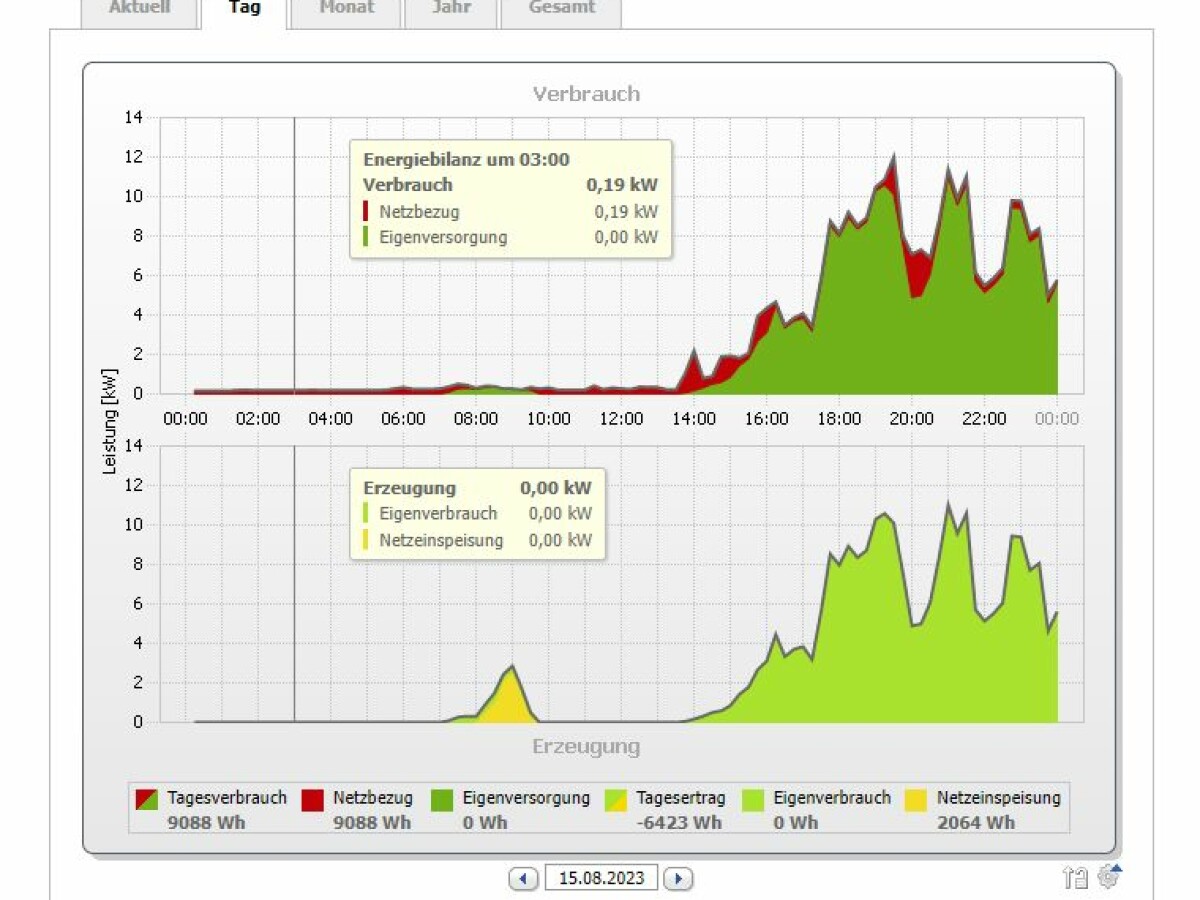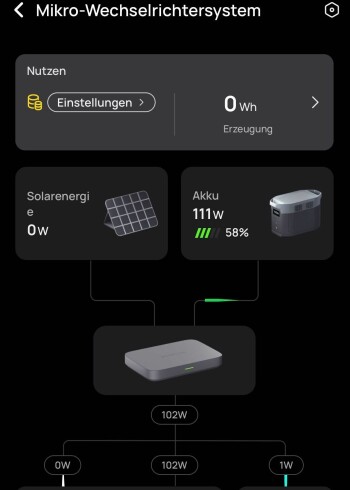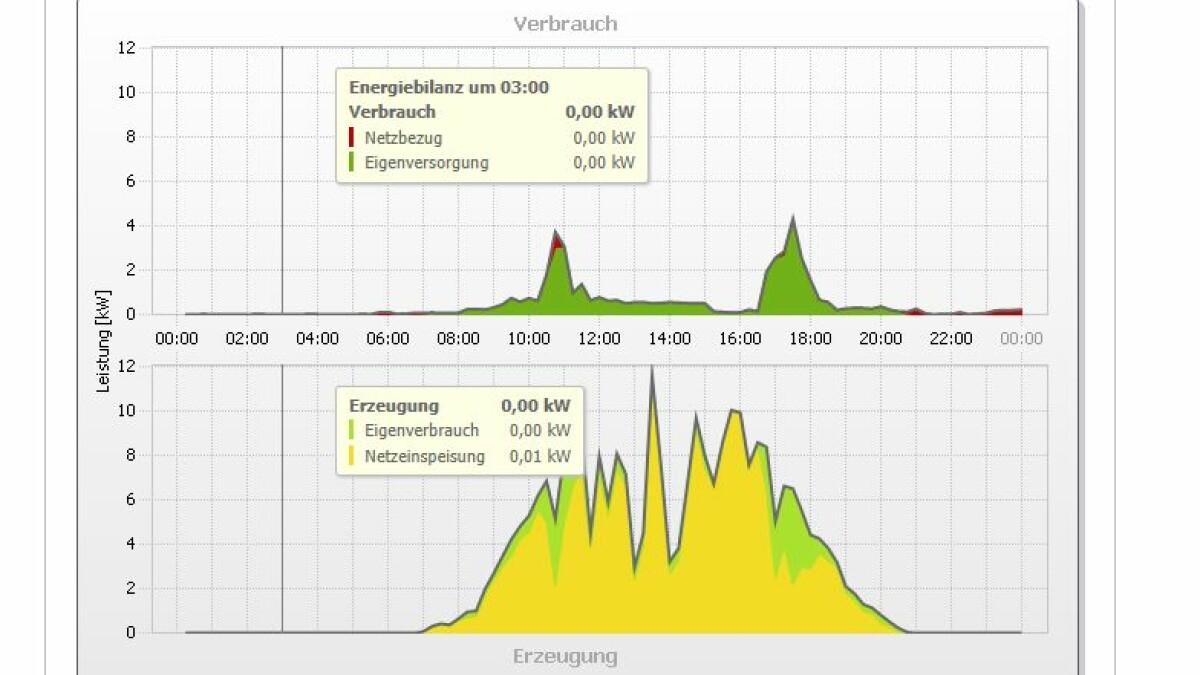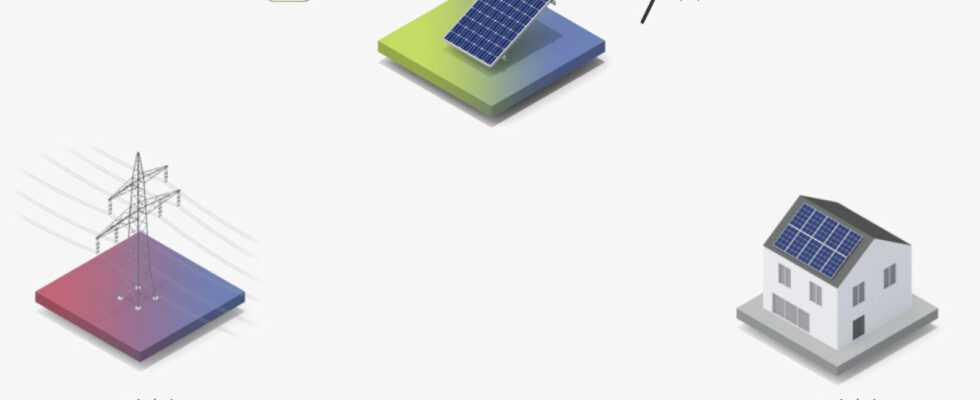We “misused” the PowerStream from EcoFlow as storage for a PV system on the roof. In this article we will show whether and how this works in summer and winter.
EcoFlow PowerStream balcony power plant 14 – 0 watt mains supply at 0:01h
Anyone planning a solar system on the roof has to make many important decisions long before installation. This includes whether the solar system should be equipped with a storage device.
This decision influences the dimensioning of the system, but the installation of a storage system also needs to be carefully considered when choosing the inverter. Things are easier for owners of balcony power plants, who now have various plug & play storage solutions available to them.
We have already taken a closer look at the complete system from EcoFlow called “PowerStream” in a test report. In comparison, the device stands out above all for its flexibility: because in the EcoFlow variant, the storage is a normal power station with all the advantages. Not only can you use the power station to draw energy in the event of a power outage, you can also easily take it with you in your car, motorhome or getaway vehicle, for example.
If you have a PV system on your roof, your “surplus problem” is usually significantly greater than with a balcony power plant. At the same time, the costs for storage are still so high that they are only worthwhile over a very long period of use.
We investigated whether the nightly electricity procurement costs, which continue to be incurred even when a solar system is present, can be reduced completely to zero with a PowerStream from EcoFlow.
The problem: base load at night
Anyone who already owns a solar system has previously invested a lot in an autonomous power supply. In the vast majority of cases, systems are installed without storage, as installing storage on paper is only worthwhile under certain assumptions. For example, the price of electricity must remain high over the long period of use and the components must last a correspondingly long time.
In any case, you need at least one skilled craftsman for the installation and usually additional advice on selecting the required components. The decision will be a significant four-digit investment.
In most cases, it’s just about covering the base load at night if the solar system doesn’t have strong consumers such as wallboxes or heat pumps in the household. Normally the base load is a night-time requirement of 1-10 kWh, which is usually caused by countless standby devices, night-time lighting and, above all, the refrigerator.

Typical base load profile: approx. 200 watts of energy requirement at 3 a.m
A PV system with 13.5 kWp output without storage is installed in the test household. The image shows a typical base load consumption of households without strong additional electrical consumers such as a heat pump. At 3 a.m. the lights are no longer on here, the refrigerator and many standby devices still use 190 watts, which have to be purchased expensively from the electricity supplier.
Can this base load be reduced or completely covered by installing a PowerStream system with storage?
The test setup: PowerStream with Delta 2 Max Powerstation
With the Delta 2 Max from EcoFlow, 2 kWh of storage capacity is available. At the same time, the electricity requirement to cover the base load in the dark in summer is usually no more than 2 kWh, with a daily production of up to 100 kWh of solar power. Mathematically, the storage size should be sufficient to reduce night-time power consumption to zero. But how do you charge the storage during the day?

Thanks to fine adjustment to zero consumption
Ideally, the PowerStream system would know exactly how much electricity is being consumed in the household at all times and provide appropriate amounts. As the test report shows, the base load must be estimated or read and PowerStream constantly delivers a preset amount (power requirement at the AC output).
At permanently less than around 200 watts, the base load here is in a range that could be covered for around 10 hours with a 2kWh power station.
If you simply plug the Delta 2 Max into the socket, the power station will be fully charged with over 2,300 watts in a short time. You can do this charging automatically every day by using a smart socket. EcoFlow itself has a socket in its range that is even automatically added to the EcoFlow Smart Home and connected to the PowerStream.
Zendure SolarFlow in the test
Secure excess energy
Balcony power plants generate the most electricity when you don’t need it. Systems like Zendure’s SolarFlow simply store “excess” energy. We do the test.
However, integration into the PowerStream system is not desired in this case because the socket called “Smart Plug” would report power requirements to the system, but the power station should not charge itself, but should be filled with solar power from the roof. In addition, the smart plug with a fuse of 10 amps is unable to cope with charging the Delta 2 Max and switches off.
Because of an existing Bosch smart home, a Bosch smart socket was used. This is also used for time-controlled charging of the plug-in hybrid via the normal socket and is protected with 16 amps, meaning it can handle up to 3,680 watts.
Because fast charging at the socket would also have the disadvantage that cloud cover would mean that additional electricity would still have to be obtained from the network operator at short notice, the throttling function of the Delta 2 Max was used. “Slow charging” can be activated using a switch on the power station’s mains connection; only 350 watts then flow into the power station via the socket on the roof. This now takes place on a time-controlled basis every day between 9 a.m. and 7 p.m. – the period is long enough to fully charge the station even with reduced power. And the power consumption of the power station is small enough to always cover this demand via solar production on the roof.
Balanced to zero demand
None of this is anything special and was previously possible with a power station and a time-controlled socket. What’s new about the PowerStream system is the ability to constantly feed the stored energy into the home network. Until now, you had to go deep into the DIY world of YouTube and Aliexpress to find such solutions.
Now all you need to do is connect the PowerStream using a suitable connection cable to the power station and the power grid using a Schuko plug. As well as various settings in the app – the phase of off-grid nights can begin:
Settings app EcoFlow PowerStream coverage base load
These settings must be made in the EcoFlow app if solar energy is to be stored during the day and delivered to the power grid at night.
Two different scenarios must be set under “planned tasks” in the PowerStream app: every morning, the power storage must be prioritized so that when the battery is charged, it is not fed back into the grid. This should only be done in the evening with the “Prioritize power supply” routine – the smart socket for charging the power station is then not activated and the power station can feed fully into the house network overnight. In the test setup, this leads to almost complete coverage of basic needs even in the dark hours of the day:

3 a.m. with 200 watts from the PowerStream: 0 kWh purchased from the network operator
Conclusion: Not a self-running no-brainer
It is currently easy to charge the Delta 2 Max from EcoFlow slowly during the day with excess energy from the roof. At the same time, the base load and day length are currently exactly the same so that energy can be obtained from the power station as needed in the dark hours: the electricity purchased from the network operator actually drops to zero, and self-consumption increases by 2 kWh per day.
On paper, you save around 70 cents by purchasing these two kWh, while a feed-in tariff of around 8 cents is foregone – around 50 cents could theoretically be saved every day. However, the combination of PowerStream and Delta 2 Max costs more than 1,500 euros. The system would have to run uninterrupted for at least 3,000 days or more than eight years for the investment to be worthwhile with electricity prices remaining the same.
However, the PowerStream itself uses up to 10 percent of the electricity flowing through it for its own operation. The various other losses are also not taken into account in the calculation: The Powerstream is charged with electricity that has already been converted at a loss by the central house inverter. When storing household electricity in a power station and then withdrawing it, non-negligible losses must also be expected. Not to be forgotten: the days are getting shorter and shorter until the end of December, and the storage requirements to cover the base load are increasing.
Update: This is how the system performs in winter
The system was commissioned and tested in midsummer with correspondingly high (solar power) surpluses and long periods of sunshine. Between eight in the morning and ten in the evening, the required 300-400 watts are almost always generated to charge the power station in gentle mode. At the same time, the period of deficiency that needs to be bridged is only comparatively short.
Everyday practice shows that in the dark season, especially between October and February, a south-facing system with 13.5 kWp is hardly able to cover the basic needs of a household with four people during the day. In some cases, almost no electricity at all is produced for weeks due to continuous cloud cover and very short days. If you simply let the system run, the battery would often be filled for days during the day using only electricity purchased from the network.
At the same time, the dark phase of the day from early afternoon to late morning is so long that the actual storage dilemma comes to light: In winter, this would have to be particularly large in order to bridge the long phase of darkness, and at the same time the storage is already closed large to even be able to be filled during the day.
In conclusion, our conclusion is that with the PowerStream from EcoFlow and a Delta 2 Max it should be possible in most cases to cover the base load of a household without a heat pump at night – at least in summer. In addition, no expensive craftsmen are required for installation; the system works plug & play with just a few settings.
At the same time, in winter this only works theoretically in most cases and it is actually impossible that this approach will be financially worthwhile in the foreseeable future if electricity prices do not continue to rise massively. Sometimes subsidies can also be offset against this.
However, this does not apply to everyone who already owns a Delta 2 Max or a comparable PowerStation from EcoFlow or is thinking about getting one. The additional cost for the PowerStream central unit will certainly be recouped somehow.
- ” Tip: The best VPN providers for more security and data protection
- » Buy balcony power plant: Comparison of the best solar systems
Don’t miss anything with this NETWORK WORLDNewsletter
Every Friday: The most informative and entertaining summary from the world of technology!
